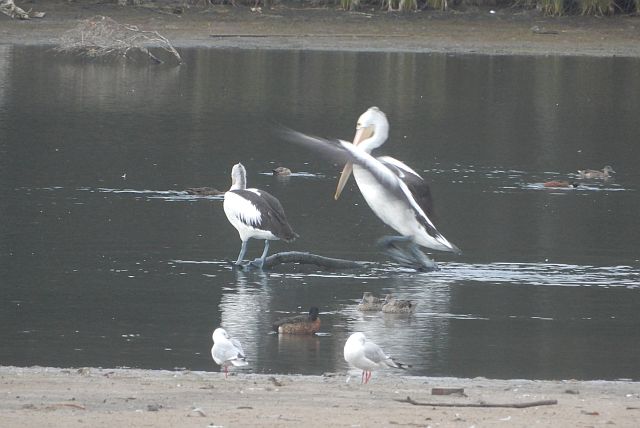
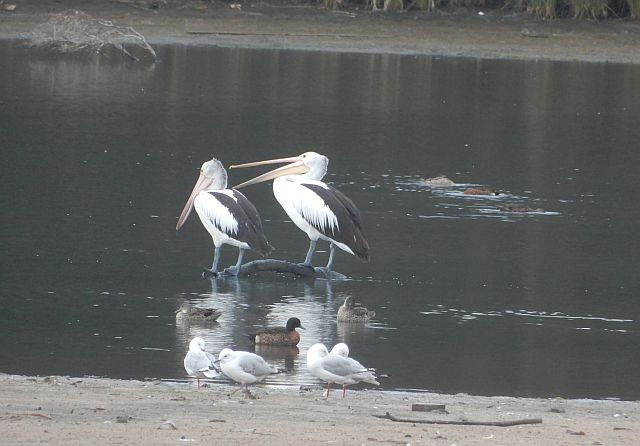 In those moments of sunshine on the south coast of New South Wales, Australia in recent days, I managed to get out and do some birding. Pelicans continue to be abundant. This is especially true at Bellambi Lagoon at low tide.
In those moments of sunshine on the south coast of New South Wales, Australia in recent days, I managed to get out and do some birding. Pelicans continue to be abundant. This is especially true at Bellambi Lagoon at low tide.The New Year began with rain, lots of rain with moments here and there of sunshine. There has been thunder and lightning both here and in New Zealand. From what I can gather through correspondence, there are parts of New Zealand as well as New South Wales getting much needed rainwater. I believe the Viking Festival in New Zealand is still going ahead. It seems that Thor is making his presence felt.

 In those moments of sunshine on the south coast of New South Wales, Australia in recent days, I managed to get out and do some birding. Pelicans continue to be abundant. This is especially true at Bellambi Lagoon at low tide.
In those moments of sunshine on the south coast of New South Wales, Australia in recent days, I managed to get out and do some birding. Pelicans continue to be abundant. This is especially true at Bellambi Lagoon at low tide.
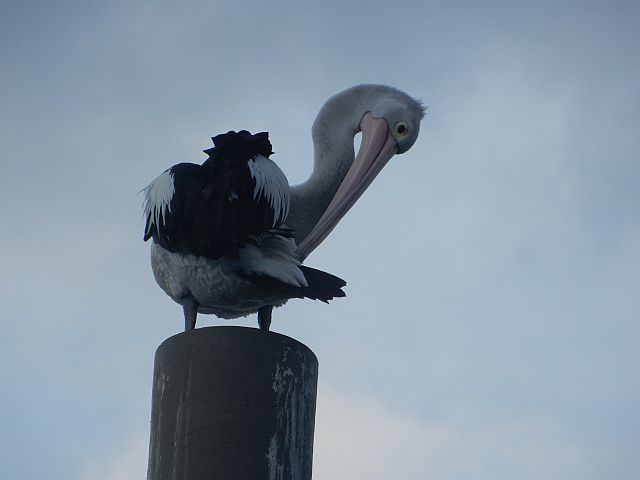 At the end of the footpath walk around the Corrimal side of Bellambi Lagoon there is a pole a particular old pelican tends to occupy during the day. If nothing else it must give this bird a grand view of the entire lagoon.
At the end of the footpath walk around the Corrimal side of Bellambi Lagoon there is a pole a particular old pelican tends to occupy during the day. If nothing else it must give this bird a grand view of the entire lagoon.
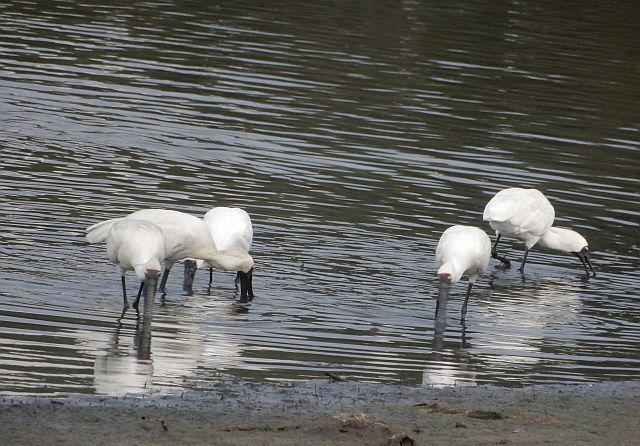
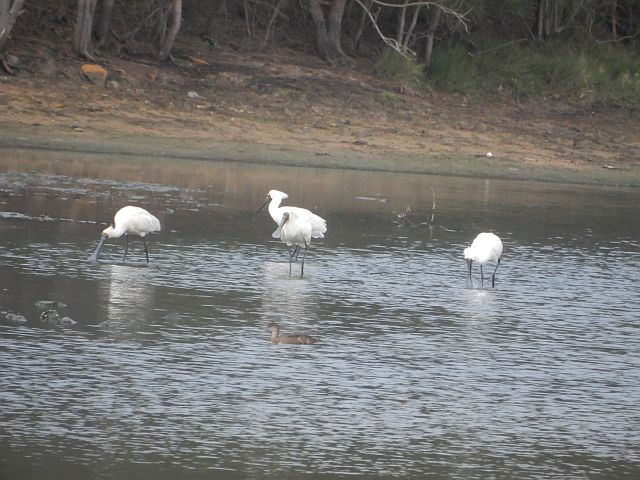 Last time I was at Bellambi Lagoon, apart from pelicans and ducks, there were Spoonbills in search of food. They were in good numbers.
Last time I was at Bellambi Lagoon, apart from pelicans and ducks, there were Spoonbills in search of food. They were in good numbers.
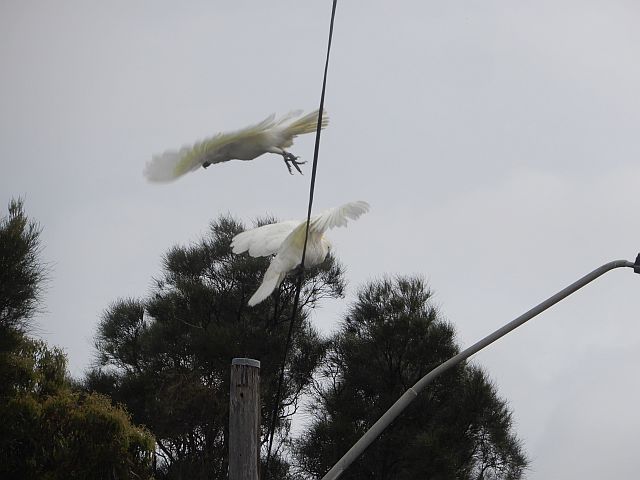
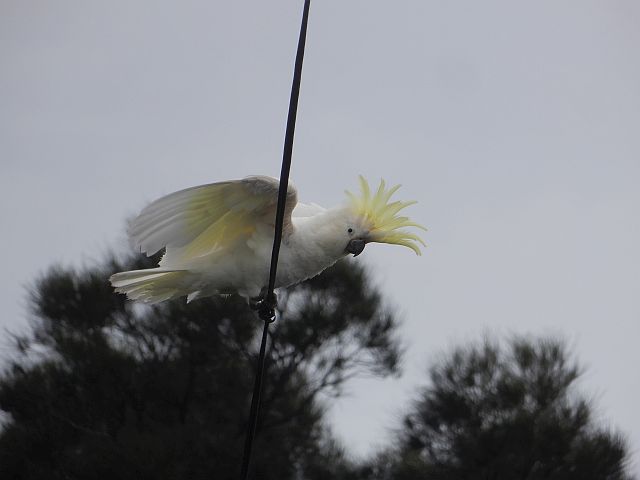 Near Towradgi Creek I came across two Sulphur-crested cockatoos having difficulty hanging onto wet wires. These cockatoos are a common species in the Corrimal/Bellambi/Towradgi area.
Near Towradgi Creek I came across two Sulphur-crested cockatoos having difficulty hanging onto wet wires. These cockatoos are a common species in the Corrimal/Bellambi/Towradgi area.
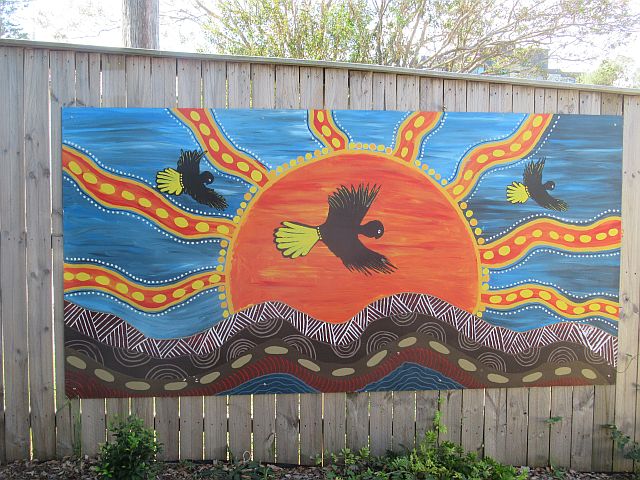 I have been in search of black cockatoos to photograph in the Towradgi Beach area. They are around, you hear their song, but presently they are proving to be difficult to catch up with. There are friends, however, who have seen them up close at Bellambi Lagoon. Here is an example of Aboriginal Street art to do with Black Cockatoos found in Kiama in 2018.
I have been in search of black cockatoos to photograph in the Towradgi Beach area. They are around, you hear their song, but presently they are proving to be difficult to catch up with. There are friends, however, who have seen them up close at Bellambi Lagoon. Here is an example of Aboriginal Street art to do with Black Cockatoos found in Kiama in 2018.
 There are butcherbirds in the Corrimal area. It appears that breeding has gone well of late. Like many bird species on the south coast of New South Wales, they nest where it is possible for them to do so. If this means near human habitation then so be it.
There are butcherbirds in the Corrimal area. It appears that breeding has gone well of late. Like many bird species on the south coast of New South Wales, they nest where it is possible for them to do so. If this means near human habitation then so be it.
 Who is that masked man? Any silver bullets around? No. Maybe a white horse nearby? No. Pity. Actually, it’s me! New rules have come in. In order to contain the corona virus, every indoor venue, supermarkets included, in NSW, Australia requires you to wear a mask. We are all Lone Rangers for the foreseeable future or Squizzy Taylors. Mind you, I am not planning on becoming a holdup man and getting ventilated by local cops so I’ll stick with the Lone Ranger. Seriously though, this is a good measure on the part of the government and may save lives.
Who is that masked man? Any silver bullets around? No. Maybe a white horse nearby? No. Pity. Actually, it’s me! New rules have come in. In order to contain the corona virus, every indoor venue, supermarkets included, in NSW, Australia requires you to wear a mask. We are all Lone Rangers for the foreseeable future or Squizzy Taylors. Mind you, I am not planning on becoming a holdup man and getting ventilated by local cops so I’ll stick with the Lone Ranger. Seriously though, this is a good measure on the part of the government and may save lives.
 Again I have been warned that walking along a Corrimal footpath headed for Bellambi Lagoon can be hazardous. White lines have been put in to presumably save lives. There is a drawing on the footpath leading to the lagoon. It is of someone run over and killed by a bike. When the local council decided to put in the white lines separating left from right they kept the drawing of the dead man. Since this drawing occupies both left and right space, we can take it as a warning. Stay to the left, the left, the left or become a casualty.
Again I have been warned that walking along a Corrimal footpath headed for Bellambi Lagoon can be hazardous. White lines have been put in to presumably save lives. There is a drawing on the footpath leading to the lagoon. It is of someone run over and killed by a bike. When the local council decided to put in the white lines separating left from right they kept the drawing of the dead man. Since this drawing occupies both left and right space, we can take it as a warning. Stay to the left, the left, the left or become a casualty.

 It has come up in conversation as to whether daring plans acted upon by the British when empire was so important to them always led to victory. The answer is no with Gallipoli being a prime example that involved both Australians and New Zealanders. As indicated by this arch that can be found in Kiama, the results of decisions made in the UK over a hundred years ago are still with us.
It has come up in conversation as to whether daring plans acted upon by the British when empire was so important to them always led to victory. The answer is no with Gallipoli being a prime example that involved both Australians and New Zealanders. As indicated by this arch that can be found in Kiama, the results of decisions made in the UK over a hundred years ago are still with us.
Winston Churchill’s original scheme was for second class British and French ships to sail up the Dardanelles and, by taking Istanbul, remove Turkey from the Great War. The Dardanelles were narrow and well fortified. Mine sweepers were used to clear the area of mines but, during the night, the Turks put more mines in the water. After a number of naval disasters, it was decided that landing men at Gallipoli and other places could still result in a fast-won victory against the Turks.
We know now, by Turkish accounts, how successful this endeavor might have been. If reinforcements had not been summoned up in time, Australian soldiers, together with New Zealanders, might have gotten further than they did. Yes. The whole thing had elements of pluck, relying on the Turks to be less than they were as fighters. Yes. Australians fought well but, in the end, it was futile. Churchill lost face and it would be decades before he would again rise to political power.
During the Second World War, Churchill as Prime Minister of Britain, was against, in 1943, a direct assault by British and American troops upon France. He felt American troops were too green. Instead he proposed an attack by British and American troops upon southern Italy where there were fewer German troops. The nature of southern Italy was not taken into account. It is mountainous and hilly.
The Germans, since they were there first, happily took the high ground making the fighting a hard slog for both the British and the Americans. One German officer in 1943 commented that southern Italy was the biggest internment camp for American soldiers and that they had done it to themselves. Fighting in southern Italy was still going on when in June 1944 the D Day landings in Normandy, France were taking place.
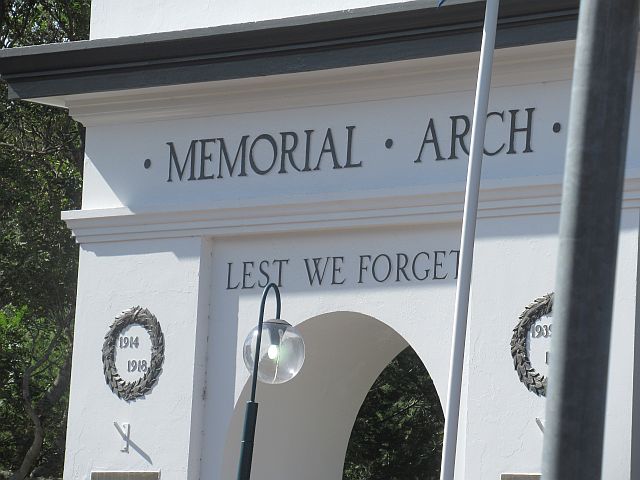
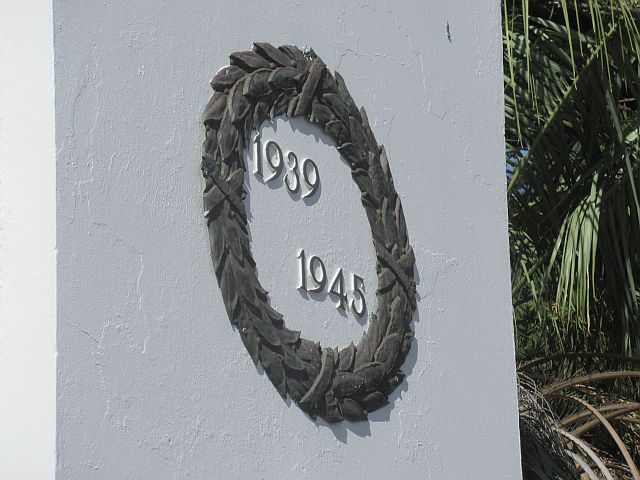 During the Second World War, our Australian Prime Minister John Curtin called for Australian troops serving in Africa to be sent back to Australia to help defend Australia from Japanese invasion. Churchill was against this move reasoning Australian soldiers were needed where they were. He was thinking of the empire and keeping it as intact as possible. Our Prime Minister Curtin, however, arranged for transport. It might have ended in calamity if those transport ships had been sunk but, as it turned out, we did get those soldiers back and they did help us defend Australia against the Japanese.
During the Second World War, our Australian Prime Minister John Curtin called for Australian troops serving in Africa to be sent back to Australia to help defend Australia from Japanese invasion. Churchill was against this move reasoning Australian soldiers were needed where they were. He was thinking of the empire and keeping it as intact as possible. Our Prime Minister Curtin, however, arranged for transport. It might have ended in calamity if those transport ships had been sunk but, as it turned out, we did get those soldiers back and they did help us defend Australia against the Japanese.
Recent historians have raised the issue of whether the use of the atomic bomb on two Japanese cities was necessary to win the war against Japan. It wasn’t in terms of there being other alternatives. These other alternatives, however, were to result in the loss of a great many American lives.
There was also the fact that the Japanese had attacked Hawaii without first declaring war on the USA. No doubt there were Americans in the know, before the bombs were used, anxious to see the effects on human population of those bombs. There were others no doubt that were keen on seeing a speedy end to hostilities that had gone on long enough. There was the view that the Japanese would fight on even though they had no chance of ultimately winning unless something extraordinary happened.
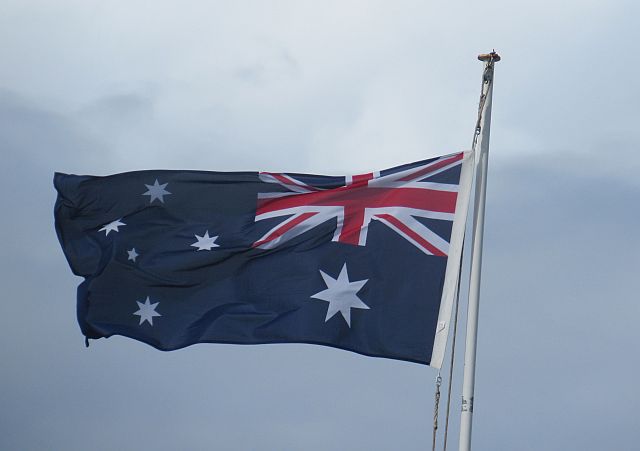 Dreams of empire and the daring-do to keep such dreams alive have slowly faded over time. Have they been replaced by Globalism? I certainly hope not but it appears that the BBC view in the UK on Globalism differs from my own. Australians in general believe in freedom and in their own identity and way of life. I hope that doesn’t change.
Dreams of empire and the daring-do to keep such dreams alive have slowly faded over time. Have they been replaced by Globalism? I certainly hope not but it appears that the BBC view in the UK on Globalism differs from my own. Australians in general believe in freedom and in their own identity and way of life. I hope that doesn’t change.

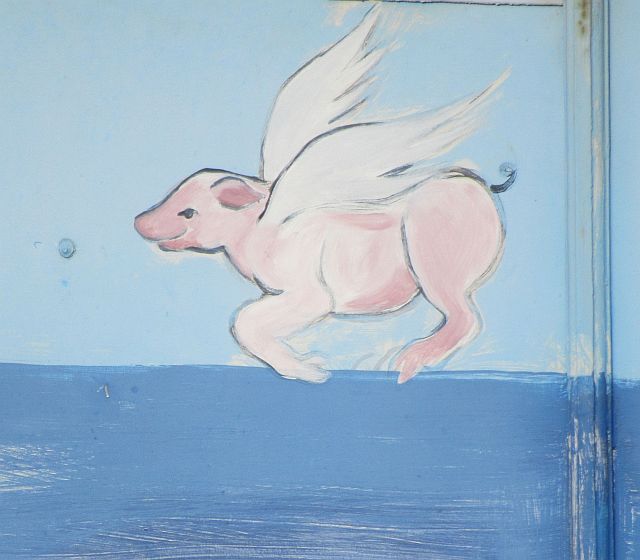 Will there be peace in our time as this abstract example of Kiama Street art indicates? I don’t know but it would be nice to have a whole decade in which we are not at war with some other nation. This other picture found in Kiama, however, might be more indicative of the possibility of peace. Do we need pigs to fly for peace to happen? Well, if so I hope they do become air-born in my lifetime.
Will there be peace in our time as this abstract example of Kiama Street art indicates? I don’t know but it would be nice to have a whole decade in which we are not at war with some other nation. This other picture found in Kiama, however, might be more indicative of the possibility of peace. Do we need pigs to fly for peace to happen? Well, if so I hope they do become air-born in my lifetime.